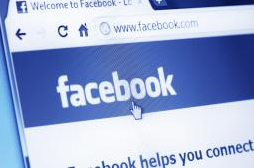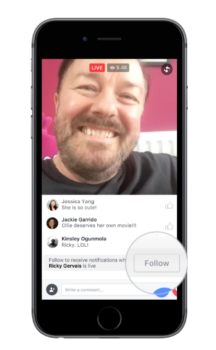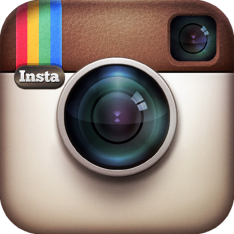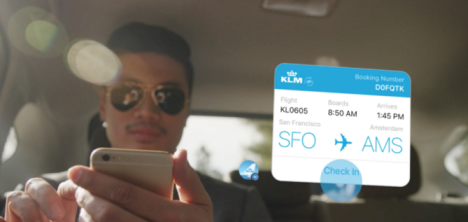Stop thinking you understand Facebook, it has plenty of surprises in store
 In this guest post, Daniel Bluzer‐Fry says we shouldn’t get too comfortable with how we think of Facebook; it’s no longer just a social network.
In this guest post, Daniel Bluzer‐Fry says we shouldn’t get too comfortable with how we think of Facebook; it’s no longer just a social network.
I once had the opportunity of seeing Adam Savage of Mythbusters speak. In his presentation on the relationship between art and science, Savage made multiple references to one of his all-time heroes, theoretical physicist Richard Feynman.
In one of these references, he recounted Feynman saying: “What can I tell you about magnetism? I don’t understand it in any terms you understand … you need a doctorate in physics to understand magnetism in the terms I understand, which means really, because I can’t explain it to you, I don’t fully understand it”.
So what the fuck does this all have to do with Facebook?
Well, plenty actually. Firstly, magnetism is relevant, as across marketing as a discipline, many of us are drawn towards and fascinated by social media and what it means for brands … with Facebook being the exemplary platform in this space.
Secondly, as marketers, making Facebook a useful platform requires an approach that is equal parts artistic and scientific. And finally, as the Feynman quote suggests, it would seem that when it comes to explaining how this powerful force works, there’s a lot of different perspectives and understandings of Facebook – ad agency, media agency, research agency, client side – and given that we can’t really gain a hell of a lot of consensus on this topic, it’s probably reasonable to suggest that we don’t fully understand Facebook.
But that shouldn’t be an issue. On the contrary, it should be something that excites us and provides us with a host of possibilities.
 Facebook isn’t what it used to be and it keeps evolving – leaving plenty of unknowns
Facebook isn’t what it used to be and it keeps evolving – leaving plenty of unknowns
Facebook has come a hell of a long way since it’s inception, and there’s plenty of things to consider that can ensure we get more utility out of it.
One of the key things that we need to shift our thinking around is the opportunity for brands to tap into the platform as a broadcast medium – and a move away from likes, shares, comments, etc.
Like it or not, people are spending more time scrolling their newsfeeds and clicking on the content that appears within the feed, thus with the immense amount of data that Facebook holds on users and the platform’s targeting capabilities, there’s plenty of opportunities for brands to connect with audiences in highly engaging ways.
I was recently at a Facebook event titled Mobile Moves People, and one of the things that came up was the synchronicity people experience on the platform –that moment that a meaningful piece of content coincidentally appears in one’s feed.
For those who have experienced this, it is rarely by chance but rather a reflection of Facebook’s targeting capabilities, which can factor in things such as geolocation, time of day, weather conditions and more to serve content that is contextually relevant.
There’s a raft of information that marketers can be harnessing to ensure they’re connecting with their audience and having an impact that can’t quite be reproduced through other mediums – for instance, think about a food retailer who can push a promotion for a hearty winter meal promotion into your feed when you’re within 500 meters of their store, on a dreary day.
 Yet the targeting capabilities on the platform are not the only thing that continues to evolve, as there’s also recently been a proliferation of new functions that have emerged that are set to change the way we engage with brands.
Yet the targeting capabilities on the platform are not the only thing that continues to evolve, as there’s also recently been a proliferation of new functions that have emerged that are set to change the way we engage with brands.
On a basic level, a new feature like instant articles – a tool that allows you to house blog content in a way that is interactive and doesn’t require users to navigate away from the platform – is going to change the way brands are currently deploying content.
Yet at the pointy end, the most exciting of this latest generation of updates is the Facebook Live feature, where people and brands can live stream in the news feed.
 Whilst some may think of this as a fairly simple innovation, from my end, this development looks as though it will provide plenty of opportunities for greater levels of engagement, and is remarkable insofar as it clashes with the fundamental nature of Facebook as a platform.
Whilst some may think of this as a fairly simple innovation, from my end, this development looks as though it will provide plenty of opportunities for greater levels of engagement, and is remarkable insofar as it clashes with the fundamental nature of Facebook as a platform.
What do I mean by this? Well, we’ve all come to know Facebook as an asynchronous communication channel, one where people and brands alike can take as much time as necessary to manicure their presentation and responses.
Facebook Live will disrupt this, and in an age where brands are all craving to be seen as more authentic in order to connect with consumers, Facebook Live can provide this kind of an opportunity to break away from the pack.
Sure it will be risky, but the kinds of pay-offs that exist may be unprecedented. Imagine broadcasting compelling live content with promotional offers to sell off surplus inventory to those attending an event using geolocation and other targeting tools (e.g. using Facebook Live at music festival to sell excess merchandise inventory towards the end of the day)?
Fortune will definitely favour the brave on this one, and who is to know what else Facebook have in the immediate pipeline.
Stop thinking you know how to gauge effectiveness
With the platform’s evolution, it’s more important than ever for marketers to realise that they need to be responsible for deciding the metrics that count – and that taking an integrated approach (understanding Facebook’s role in the communications mix) is key.
Having attended a session on measuring effectiveness with Steve Lockwood, head of marketing science at Facebook, it becomes apparent that their team are working hard to help marketers recognise the kinds of ROI that exist on the platform.
One of the best examples of measuring effectiveness, was the use of the platform’s geolocation capabilities for a tourism brand, to track how their targeted advertisements had influenced visitors behaviour.
Facebook have an immense capability to create control and test groups with the way the use targeted advertising, and are also able to factor in other communications exposure to understand ROI.
In the above example, through people logging on to Facebook whilst travelling, they were able to track the volume of incremental people in the test group visiting country x compared to the control group who weren’t exposed to the advertisements on Facebook. Combining this with the average number of days travelling in the country and the average daily spend by tourists, they could illustrate the incremental ROI of employing the platform in the communications mix.
Impressive to say the least.
But in truth, and unsurprisingly, they don’t have all the answers. Why? Well, for one, they quite simply don’t have enough case studies.
Q: How do you measure ROI on using Facebook Live? A: It’s just come out, so we don’t know.
Perhaps the even more relevant point is that such a question is unreasonable in the first place. After all, the way measurement should be approached should be both holistic and specific. Just thinking about the raft of variables that we may need to factor in – things like context (where they are exposed, if it is a first or second screen experience, other communications channels being used), category and business objectives make it more important than ever for marketers to dig deep, and get beyond a lot of the bullshit metrics that get peddled around these days.
Sure it’s complex, but it’s more important than ever for marketers to think in new, creative and holistic ways to measure effectiveness on the platform (Facebook and their creative partner agencies are also keen to help on this front given the challenge that this is!).
Stop thinking about Facebook (and ‘social media’) as communications channel
 Finally – and hopefully this one engages the most scathing critics of social media – it should be noted that the opportunities that both Facebook and Instagram offer extend far beyond communications when it comes to generating value for marketers.
Finally – and hopefully this one engages the most scathing critics of social media – it should be noted that the opportunities that both Facebook and Instagram offer extend far beyond communications when it comes to generating value for marketers.
Given its scale and capabilities, it’s not unreasonable to consider Facebook as essentially the world’s largest consumer panel. So as marketers, purely viewing the platform as a means of communicating and influencing behaviour quite simply neglects an entire world of possibilities around insights.
Smart brands and agencies are finding ways to harness social as a tool that can simultaneously engage customers and generate insights that go well above and beyond how they use the platform.
Recruiting people for one off surveys and external panels – something which is not particularly difficult in high involvement categories – can give brands the agility to explore everything from new product ideas through communication concepts.
And it doesn’t stop there. With the vast amounts of content that are generated on social platforms, there’s plenty of material to decode for insights.
 Take for instance the ability to employ semiotic analysis using a platform like Instagram.
Take for instance the ability to employ semiotic analysis using a platform like Instagram.
Semiotics is the study of signs and meaning, so suppose for example, a brand was wanting to understand different expressions of Australianess by males on Australia Day, they could collect a stack of stimulus from the content that has been posted by a cross section of men (from residual Aussie blokes through to progressive Australian males) to decode key themes that resonate and identify connections and opportunities with their brand.
Beyond that, with people’s food porn obsession, there’s plenty of ways the imagery that is out there can be tap into these social platforms to both inform and drive innovation.
So with that said, hopefully we can all continue to rethink how much we know about Facebook (and all forms of social media for that matter), and continue learning and finding ways to grow brands moving forward.
Daniel Bluzer‐Fry is a CX Strategist at Tribal Melbourne. DDB Group is an official Facebook creative agency partner





Well written piece. I’m interested in the tourism example you provided, but my first response is a wariness around unaccounted-for variables in the decision to stay longer. Are you able to parse this example out a bit more?
User ID not verified.
Hi Daniel, good insights and mature perspective. We need more article like this unveiling the hidden possibilities rather than the obvious silly statements.
User ID not verified.